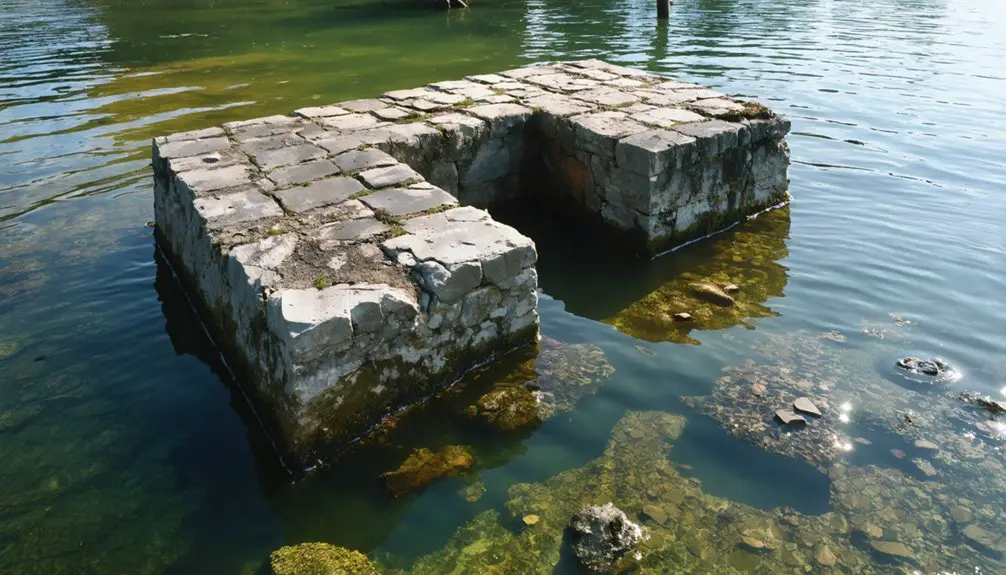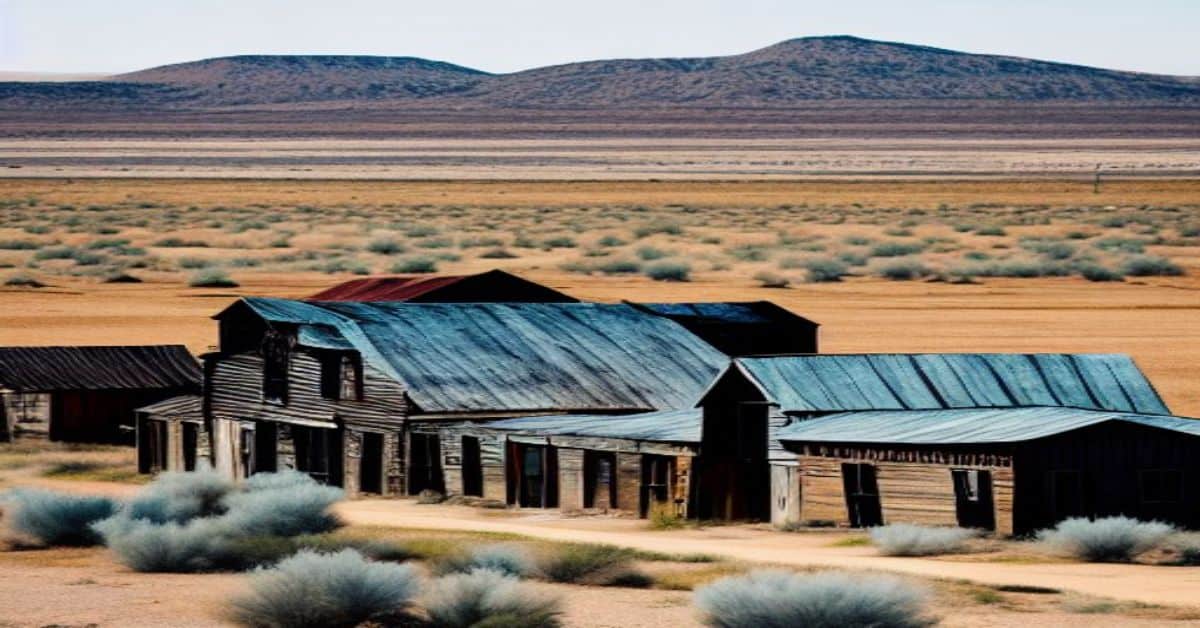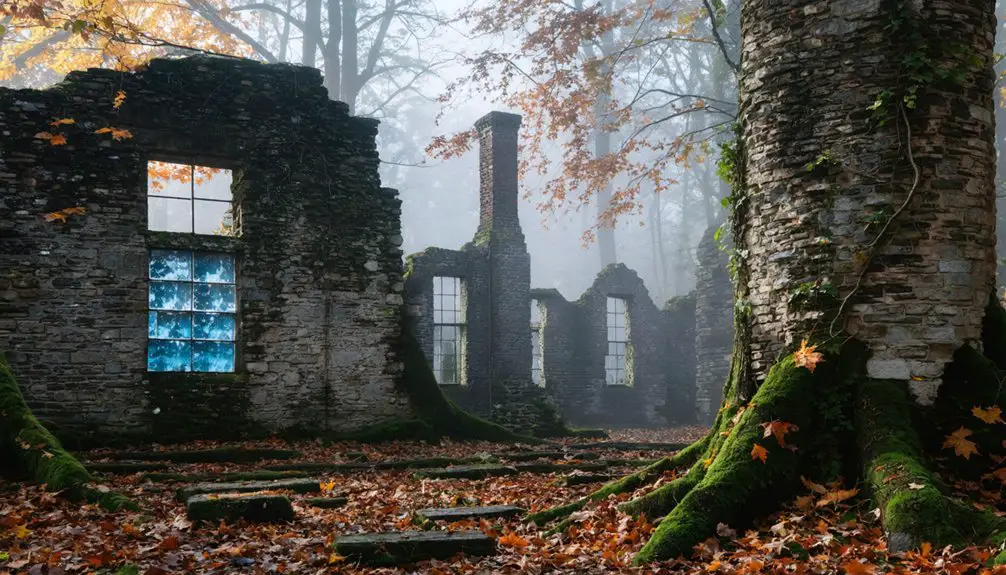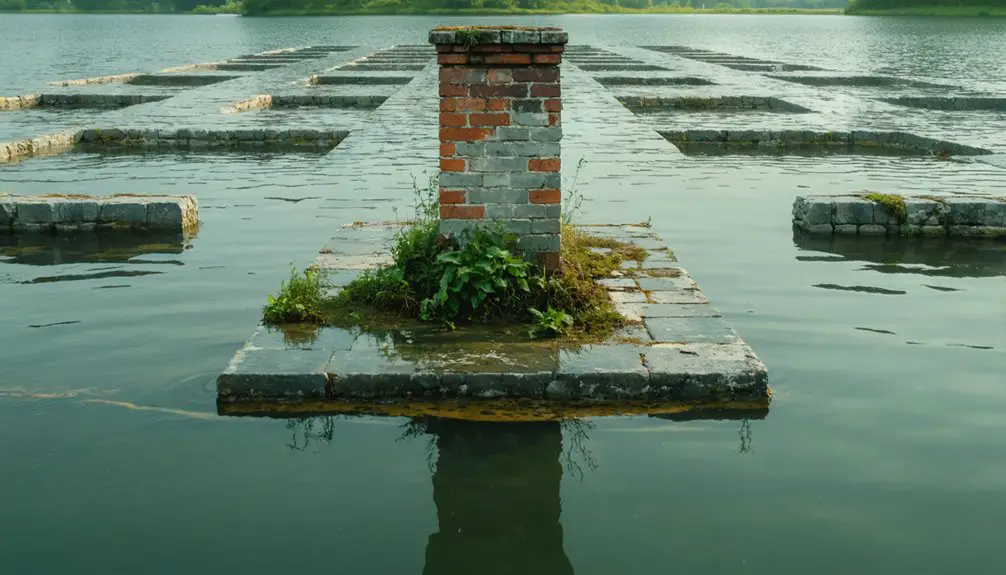You’ll find Greenwich’s story beneath the waters of Massachusetts’ Quabbin Reservoir, where a vibrant farming community once thrived. In 1938, this Swift River Valley town, along with three others, was sacrificed to create Boston’s main water supply. Over 2,500 residents were displaced, with 7,000 graves relocated and generations of memories submerged. While the reservoir now serves as a wilderness sanctuary, Greenwich’s streets, homes, and community spirit still whisper their tales from the depths.
Key Takeaways
- Greenwich was one of four Massachusetts towns permanently submerged in the 1930s to create Quabbin Reservoir for Boston’s water supply.
- The town covered approximately 50 square miles and had a thriving agricultural economy with 77 farms by 1890.
- Over 2,500 residents were displaced when the state used eminent domain to acquire land for the reservoir project.
- The flooding process began after 1938’s Farewell Ball, requiring the relocation of over 7,000 graves from the condemned towns.
- Today, Greenwich lies beneath 400 billion gallons of water, with only historical records and museums preserving its cultural heritage.
Early Settlement and Community Life in Greenwich
When settlers from Massachusetts first purchased land between the Asamuck and Patomuck rivers in 1640, they laid the foundation for what would become Greenwich, Connecticut. Captain Daniel Patrick and Robert Peaks negotiated with local Native American sachems, establishing the settlement’s legal basis at Greenwich Point, then called Monakewego.
The early settlers faced territorial disputes between Dutch, English, and Native American groups, but they persevered. By the 1730s, the community sprawled across 50 square miles, with Elizabeth Feake emerging as a notable founding mother. The settlers devoted their first two hundred years primarily to acquiring and cultivating farmland. The fertile soil supported 77 farms by 1890, making agriculture a cornerstone of the local economy.
The town’s cultural diversity blossomed as distinct neighborhoods formed – Irish railroad workers near Greenwich Avenue, Italian stonemasons in Chickahominy, Poles in Glenville’s mill district, and Germans in Byram’s industrial area. Each ethnic enclave contributed unique traditions and skills to Greenwich’s rich social fabric.
The Swift River Valley’s Natural Heritage
Miles away from Greenwich’s urban development lies the pristine Swift River Valley, a natural sanctuary spanning 439 acres of diverse landscapes.
You’ll find a rich tapestry of forest, swamp, fields, and uplands, where white pine and mixed hardwoods have reclaimed the land since the great hurricane of 1938.
The valley serves as a vital breeding ground for three listed species including the majestic Bald Eagle, Common Loon, and Pied-billed Grebe.
The valley’s natural diversity shines through its abundant wildlife habitat, where deer, beaver, bear, and bobcat roam freely alongside numerous bird species.
The valley teems with life, as diverse wildlife from mighty bears to nimble bobcats share their untamed sanctuary beneath the forest canopy.
The East Branch of the Swift River, flowing through majestic old pine and hemlock, serves as a crucial artery of this ecosystem. The waterway is recognized as one of Massachusetts’ most picturesque streams.
As part of the larger Quabbin watershed‘s 120,000 acres of protected land, this unfragmented forest creates an essential corridor for wildlife, connecting the reservoir to Harvard Forest and maintaining the region’s ecological integrity.
The Decision to Create Quabbin Reservoir
You’ll find a complex tension between engineering ambitions and local rights in the decision to create Quabbin Reservoir, as state authorities prioritized Boston’s growing water needs over the autonomy of Swift River Valley communities.
The project’s roots stretched back to 1893 studies that identified the valley as an ideal reservoir site, though mandatory water metering temporarily delayed the need for expansion.
Chapter 375 provided the legal foundation for acquiring land and water rights through eminent domain.
When population growth renewed pressure for additional water sources in the 1930s, the state enacted legislation authorizing the reservoir’s construction, effectively condemning four towns to disappear beneath its waters. After completion in 1939, it took seven full years for the reservoir to fill completely.
Engineering Vs Local Rights
The creation of Quabbin Reservoir sparked an intense battle between engineering ambitions and local rights, as the Metropolitan District Commission wielded its considerable legal authority to displace four Massachusetts towns.
Engineering ethics clashed with community resilience as local residents fought to preserve their homes, farms, and way of life.
You’ll find that while the Commission’s eminent domain powers were legally sound, backed by a 1931 Supreme Court ruling, the human cost was devastating.
Property owners received mandated compensation, but many contested the valuations, arguing they couldn’t put a price on generations of heritage.
The Commission’s engineers focused on technical solutions – designing dams, tunnels, and aqueducts – while downstream communities grappled with the loss of their ancestral lands and the forced restructuring of their local economies.
The massive construction project provided steady Depression jobs that temporarily eased tensions between engineers and locals, though the underlying grief remained.
Water Supply Planning History
While Boston’s metropolitan area experienced rapid growth in the late 1800s, forward-thinking planners recognized an impending water crisis that would shape the region’s future. In 1893, the Massachusetts Board of Health issued an essential report predicting dramatic population growth and increasing water demand, leading to the creation of the Metropolitan Water District in 1895.
You’ll find that early planners initially focused on the Nashua River, completing the Wachusett Reservoir in 1908. Through conservation efforts, they managed to delay the need for additional water sources. The reservoir’s construction required flooding six and a half miles of land, dramatically altering the landscape of towns like Boylston and Clinton.
However, by 1922, studies confirmed what many had suspected – the Swift River Valley would need to become the next major source of water for the region. This decision set the stage for one of the most significant water infrastructure projects in Massachusetts history. The eventual construction of the Quabbin Aqueduct would enable water to flow directly from the new reservoir to the Wachusett Reservoir.
Displacement and Relocation of Residents
When the state displaced over 2,500 residents to create Quabbin Reservoir, you’d witness the heart-wrenching separation of families who’d lived as neighbors for generations in Greenwich and other valley towns.
You’d find these tight-knit communities scattered across Massachusetts, with former neighbors now settling miles apart in unfamiliar surroundings.
The search for new homes proved especially difficult for farming families, who needed not just houses but suitable agricultural land to maintain their livelihoods. The emotional weight of leaving was captured during the Farewell Ball in 1938, where over 2,000 residents gathered for one final community celebration.
Emotional Toll on Families
Profound grief struck Greenwich’s community when approximately 2,500 residents faced mandatory displacement from their ancestral homes in 1938.
You’ll find stories of emotional trauma as families watched their homes being demolished, their community ties severed, and generations of memories erased beneath the rising waters.
The community grief intensified during farewell events that marked their final gatherings. You can imagine the heartbreak of watching neighbors exhume over 7,000 graves of loved ones for relocation.
Local support networks, built over generations, crumbled as families scattered to unfamiliar towns.
Today’s descendants still carry the weight of this displacement, gathering at reunions to preserve the stories of their lost community and maintain connections to their submerged hometown.
Scattered Community Bonds
Following the disincorporation of four towns in April 1938, approximately 2,500 residents faced the harsh reality of leaving their homes behind as the Quabbin Reservoir project moved forward.
The community fragmentation that ensued created deep wounds, as families who’d lived as neighbors for generations were scattered across different locations. This social disconnection permanently altered the fabric of these close-knit communities, with no formal relocation programs to help keep neighbors together.
- Long-established social networks dissolved over the nearly 20-year removal process
- Local governance structures and community organizations ceased to exist
- Multi-generational family bonds were strained as relatives relocated to different areas
- Community gathering places and shared spaces were destroyed, eliminating natural meeting points for maintaining relationships
Finding New Homes Elsewhere
Between 1922 and 1938, the Quabbin Reservoir project forced approximately 2,500 residents from their ancestral homes across Dana, Greenwich, Enfield, and Prescott.
Without any state support programs for housing or employment, you’d face significant housing challenges as you searched for a new place to live. The state simply offered monetary compensation for properties, and if you refused, they’d seize your land through eminent domain.
Despite these hardships, community resilience emerged as displaced families supported one another through the change.
You’d likely settle in surrounding towns, though some residents moved farther away, scattering tight-knit communities that had existed since the 1740s.
The lack of formal relocation assistance meant you’d have to rebuild your life independently, relying on personal resources and informal support networks.
Final Days of a Vanishing Town
As Massachusetts state law sealed Greenwich’s fate on April 28, 1938, the once-vibrant community began its final transformation into a submerged memory.
You’d have witnessed the disappearing landscapes as crews systematically razed and burned homes, businesses, and cherished landmarks. Despite this forced exodus, community resilience shone through as residents preserved what they could of their heritage before the waters claimed their town.
- Workers exhumed 7,500 graves, relocating ancestors to higher ground
- The Boston and Albany Railroad’s Athol Branch fell silent as tracks were removed
- Churches and schools closed their doors forever as utilities were shut down
- Families watched their properties transform into rubble before the final flooding
The reservoir’s filling on August 14, 1939, marked Greenwich’s final breath before slipping beneath the rising waters.
Engineering Marvel: Building the Reservoir
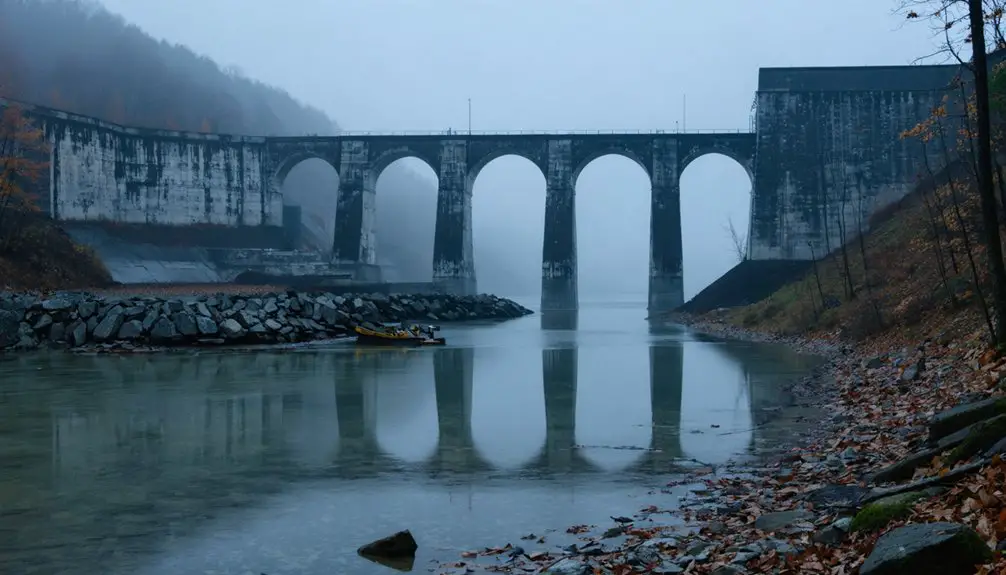
You’re witnessing one of America’s most ambitious water infrastructure projects, with two massive earth-filled dams – the Winsor Dam and Goodnough Dike – each stretching over 2,000 feet to create what would become Massachusetts’ largest reservoir.
The engineering feat required clearing 60,000 acres of land and implementing the hydraulic fill method, where flowing water deposited embankment materials to construct dams capable of containing depths up to 150 feet.
Despite the environmental transformation that submerged four towns, the project’s meticulous planning guaranteed a reliable water supply for Boston through the 25-mile Quabbin Aqueduct system, which continues to serve millions today.
Constructing Massive Water Infrastructure
The construction of Quabbin Reservoir stands as one of Massachusetts’ most ambitious engineering projects, shaped by legislative groundwork laid in 1926 through Chapter 375.
You’ll find this massive infrastructure challenge required unprecedented community resilience, as engineers tackled the immense task of creating two earth-fill structures – Winsor Dam and Goodnough Dike – to hold over 400 billion gallons of water.
- A 25-mile underground aqueduct, blasted through bedrock, connects the reservoir to Boston
- Construction crews cleared all vegetation and buildings from the reservoir bed to prevent contamination
- The filling process took seven years to reach full capacity after completion in 1939
- The project required extensive tunneling operations, making it one of the most hazardous engineering feats of its time
Environmental Impact Assessment Results
Beyond the physical construction achievements, environmental assessments of Quabbin Reservoir reveal both challenges and successes in maintaining water quality and ecosystem health.
You’ll find that early concerns about acid rain in the 1980s and 1990s were effectively addressed through Clean Air Act amendments, which reduced emissions from coal-burning power plants affecting New England.
Today’s focus on environmental sustainability includes aggressive management of invasive species through shoreline removal projects and ecological restoration initiatives.
The Swift River release system maintains downstream water flows of 20 million gallons daily, ensuring watershed sustainability.
You’re benefiting from ongoing monitoring programs that protect water quality while balancing reservoir storage needs.
The MWRA’s transparent evaluation process keeps you informed about water system impacts, demonstrating a commitment to both environmental stewardship and community involvement.
Preserving Greenwich’s Memory
While Greenwich physically vanished beneath Quabbin Reservoir’s waters in 1938, extensive preservation efforts guarantee its memory lives on through carefully maintained town records, church documents, and historical photographs.
You’ll find its legacy preserved through oral histories shared at community reunions, and through partnerships between UMass Special Collections and the Swift River Valley Historical Society.
- Over 7,500 bodies were respectfully exhumed and reinterred in nearby cemeteries
- The Quabbin Memorial Park honors the sacrificed towns through educational programs and tours
- Historical collections span from the 1730s to 1938, including Selectmen meetings and church records
- Local historical societies continue gathering personal accounts and stories to maintain cultural memory
Environmental Impact and Transformation
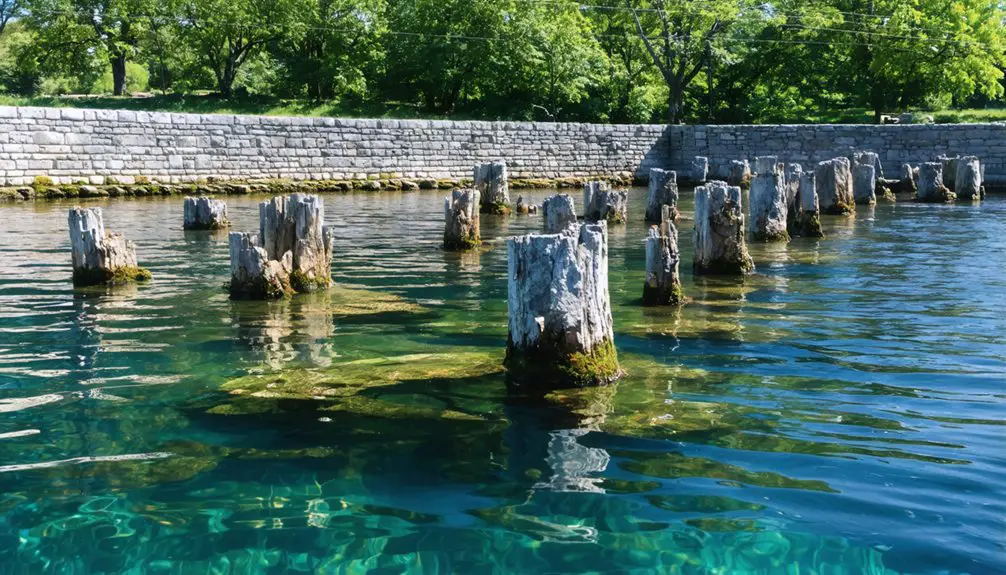
Flooding Greenwich and its neighboring towns to create Quabbin Reservoir in 1938 didn’t just preserve a cultural legacy – it sparked profound environmental changes that continue shaping Massachusetts today.
The transformation created a massive 400-billion-gallon reservoir that now serves 2.5 million residents, but it fundamentally altered the Swift River Valley’s ecosystem and water flow dynamics.
You’ll find remarkable examples of environmental restoration in the pristine forests surrounding the reservoir, which naturally filter drinking water without artificial treatment.
However, this achievement came at a cost to community resilience, as nearby towns still face water quality challenges despite their proximity to New England’s largest water supply.
The ongoing battle against invasive species and emerging threats like proposed landfills shows how protecting this crucial resource requires constant vigilance.
Legacy of the Lost Communities
As the waters of Quabbin Reservoir rose in 1938, they erased more than just four towns from the map – they submerged generations of cultural heritage and community bonds.
Yet, the spirit of Greenwich and its neighboring towns lives on through the remarkable community resilience of displaced residents and their descendants.
You’ll find their stories preserved in museums, historical societies, and Elena Palladino’s chronicles of the Swift River Valley.
- The emotional farewell ball in Enfield marked the community’s final gathering, symbolizing both an ending and their enduring connection.
- Over 7,500 ancestors were respectfully reinterred, honoring family ties beyond the valley.
- Dana Common stands as a tangible reminder, with its stone steps and cellar holes telling silent stories.
- Former residents maintained their cultural heritage through shared histories and relationships well beyond 1938.
Modern Day Quabbin: Greenwich Beneath the Waters
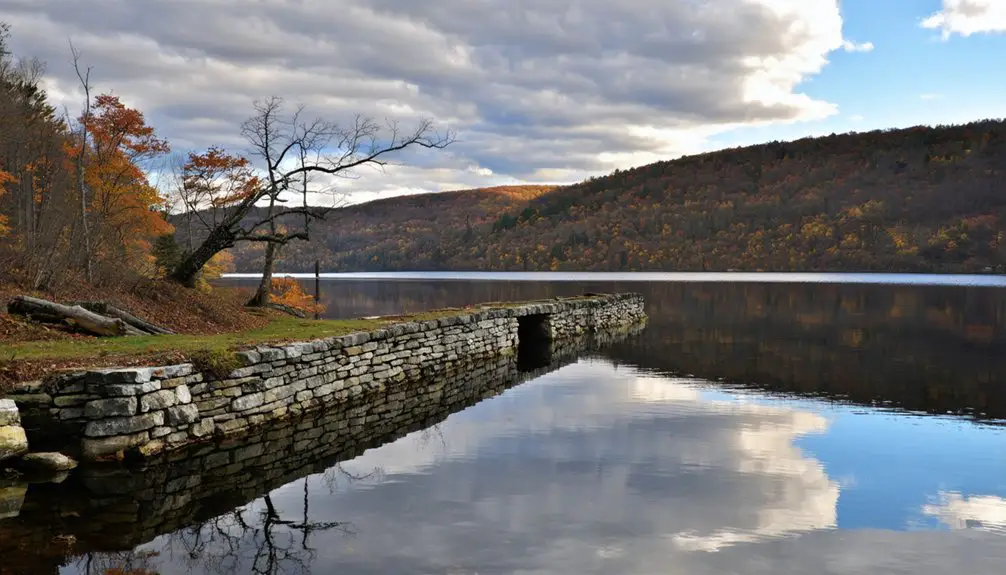
Today, beneath Quabbin Reservoir‘s vast waters, the former town of Greenwich rests among 39 square miles of submerged Massachusetts land.
While underwater archaeology reveals little of the original structures that once stood proud in Greenwich, the reservoir’s creation has transformed the region into a thriving wilderness sanctuary.
You’ll find bald eagles soaring above the waters that cover the town’s forgotten streets, while black bears, moose, and coyotes roam the protected shoreline where Greenwich’s residents once lived.
The northern hardwood forests that have reclaimed the surrounding land stand as silent sentinels to this submerged history.
Though the community’s physical presence vanished beneath 40,000 acres of water in 1938, their story lives on in the protected wilderness that now defines Quabbin.
Frequently Asked Questions
What Personal Items Were Residents Allowed to Take During the Evacuation?
Though evacuation policies seemed strict, you’d be surprised – you could take daily essentials, portable furniture, family photos, documents, kitchenware, and even cherished heirlooms like clocks to your new home.
Are There Any Surviving Buildings From Greenwich Above Water Today?
You won’t find any surviving Greenwich buildings above water today. Despite historical preservation efforts, everything was intentionally razed before flooding. Only underwater archaeology reveals traces of the town’s structures beneath Quabbin’s surface.
How Deep Is the Water Over Greenwich’s Former Town Center?
You’ll find approximately 151 feet of water over Greenwich’s former town center, making it one of the deepest spots in Quabbin Reservoir where the submerged community once thrived.
Did Any Residents Refuse to Leave During the Forced Relocation?
While refugee stories and historical accounts reveal trauma and reluctance, you won’t find evidence of residents actively refusing to leave. Everyone eventually complied with the state’s mandatory evacuation by the 1938 deadline.
Can Scuba Divers Explore the Submerged Ruins of Greenwich?
Want to explore Greenwich’s underwater secrets? You can’t – scuba diving and underwater photography are strictly prohibited at Quabbin Reservoir to protect Boston’s water supply and preserve the historical remains.
References
- http://scua.library.umass.edu/greenwich-mass-3/
- https://en.wikipedia.org/wiki/Quabbin_Reservoir
- https://quabbinhouse.com
- https://vitabrevis.americanancestors.org/2019/09/lost-towns-of-the-quabbin
- https://www.mass.gov/news/the-quabbin-reservoir-and-the-laws-that-shaped-it
- https://greenwichhistory.org/short-history-of-greenwich/
- http://explorewmass.blogspot.com/2007/02/greenwich-mass-1754-1938.html
- https://archive.org/download/yehistorieofyeto00mea/yehistorieofyeto00mea.pdf
- https://www.greenwichtime.com/local/article/Born-in-conflict-a-town-called-Greenwich-emerges-6094442.php
- https://greenwichhistory.org/greenwich-historic-communities/
